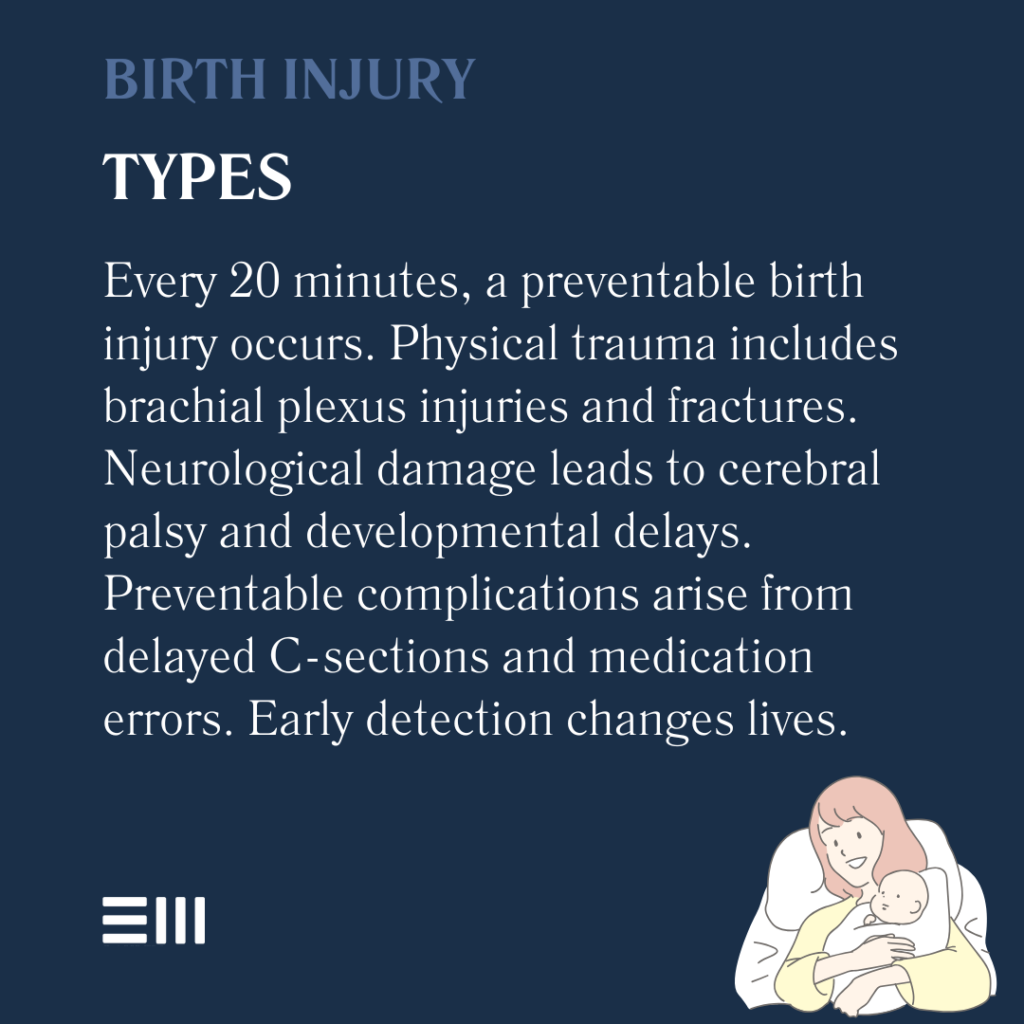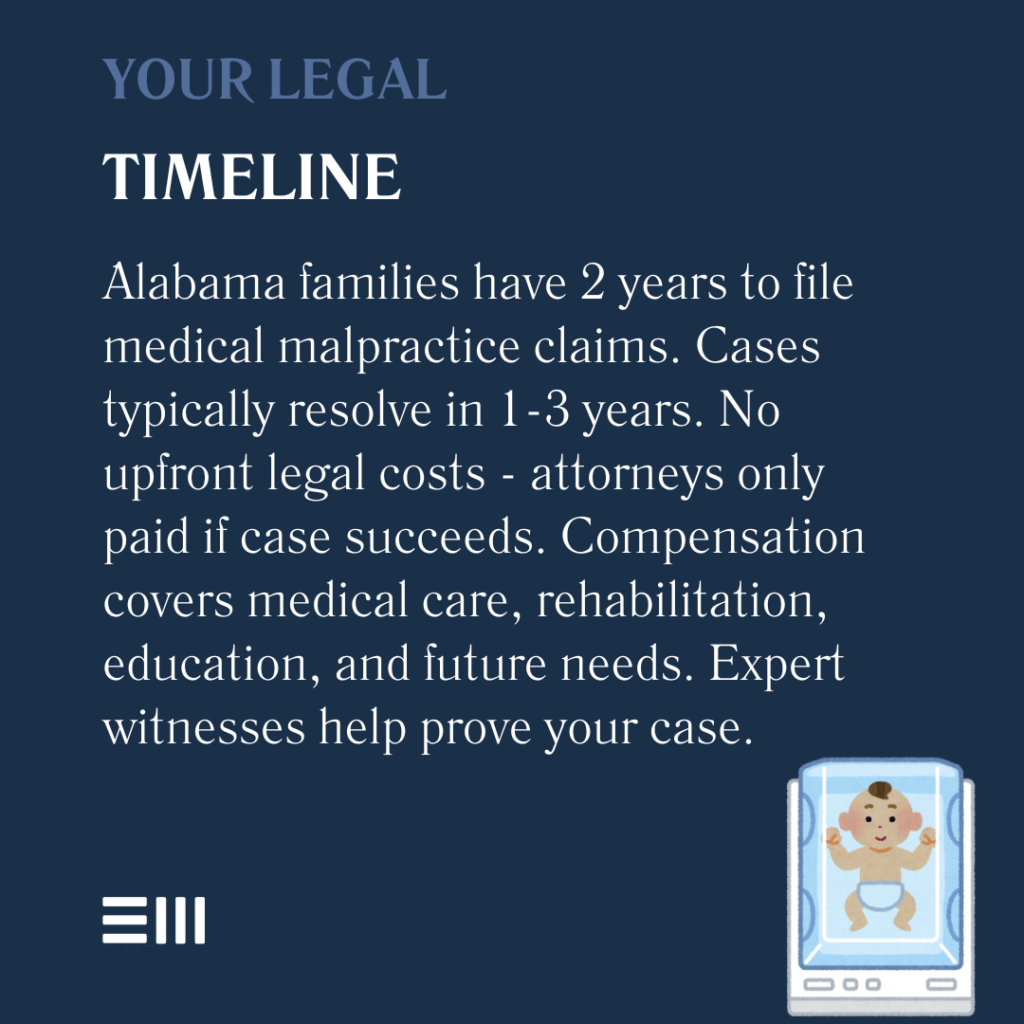
Every 20 minutes in the United States, a baby suffers a birth injury that could have been prevented.
Behind each statistic lies a family forever changed by a moment that should have brought joy, not trauma.
In Alabama, families affected by medical negligence during childbirth have rights and options for seeking justice.
Understanding Birth Injuries and Medical Negligence
The journey of childbirth requires precise medical care and attention. When healthcare providers fail to meet the established standard of care, the consequences can be devastating for both the child and family.
Birth injuries differ from birth defects, as injuries typically result from actions or oversights during pregnancy, labor, or delivery.
Medical professionals must carefully monitor both mother and child throughout pregnancy and delivery, making swift decisions when complications arise.
When these responsibilities are neglected, serious injuries can occur, potentially affecting a child’s entire life. Understanding the full scope of birth injuries helps families recognize potential signs of negligence and take appropriate action.
Common Types of Birth Injuries
Birth injuries manifest in various ways, each requiring different levels of medical intervention and ongoing care.
Physical Trauma
Healthcare providers must be particularly vigilant in preventing and addressing physical injuries that can occur during the birthing process.
Here are the most common types of physical trauma that may indicate medical negligence:
- Brachial plexus injuries;
- Fractures;
- Facial paralysis;
- Cephalohematoma;
- Caput succedaneum;
- Shoulder dystocia;
- Spinal cord injuries; and
- Soft tissue injuries.
Early identification and proper treatment of these injuries significantly impact a child’s recovery prospects and long-term outcomes.
Neurological Injuries
Neurological complications during birth can lead to lasting developmental challenges.
These serious conditions often result from oxygen deprivation or physical trauma during delivery:
- Cerebral palsy;
- Hypoxic-ischemic encephalopathy (HIE);
- Seizure disorders;
- Cognitive impairments;
- Developmental delays;
- Brain damage from oxygen deprivation;
- Nerve damage; and
- Motor function disabilities.
Prompt recognition and intervention in these cases can significantly affect the extent of long-term damage and potential for recovery.
Preventable Complications
Many birth complications can be avoided with proper medical care and monitoring.
Below are common preventable complications that may indicate negligence:
- Jaundice leading to kernicterus;
- Infections;
- Medication errors;
- Delayed C-section complications;
- Maternal injuries;
- Gestational diabetes complications;
- Preeclampsia-related injuries; and
- Placental abruption consequences.
Proper medical monitoring and timely intervention can prevent many of these complications from escalating into serious injuries.

Signs of Medical Negligence in Neonatal Care
During Pregnancy
Prenatal care requires consistent monitoring and prompt response to potential complications.
Here are key indicators that may suggest negligent prenatal care:
- Failure to identify maternal health issues;
- Inadequate monitoring of fetal development;
- Missed diagnosis of serious conditions;
- Inappropriate medication administration;
- Delayed response to complications;
- Poor documentation of prenatal care;
- Failure to order appropriate tests; and
- Misinterpretation of test results.
Regular prenatal monitoring and appropriate response to warning signs can prevent many serious complications.
During Labor and Delivery
The delivery process requires careful attention and swift response to emerging complications. These signs may indicate negligent care during labor and delivery:
- Improper use of delivery tools;
- Failure to recognize fetal distress;
- Delayed cesarean section;
- Poor communication between medical staff;
- Inadequate monitoring of vital signs;
- Improper administration of Pitocin;
- Failure to manage maternal blood loss; and
- Inadequate response to umbilical cord issues.
Quick recognition and response to these issues can prevent severe birth injuries and ensure better outcomes.
Post-Delivery Care
Careful monitoring during the immediate post-delivery period is crucial for identifying and addressing complications. Watch for these signs of negligent post-delivery care:
- Delayed treatment of complications;
- Improper medication dosing;
- Insufficient monitoring;
- Failure to diagnose conditions;
- Inadequate parent education;
- Poor newborn screening practices;
- Delayed response to respiratory distress; and
- Inadequate jaundice monitoring.
Proper post-delivery care and monitoring can prevent many serious complications from developing.
Legal Rights for Alabama Families
Compensation Areas
Families affected by birth injuries may be eligible for various types of compensation to address both immediate and long-term needs. Here are the key areas where compensation may be available:
- Medical expenses (current and future);
- Rehabilitation costs;
- Special education needs;
- Lost earning potential;
- Pain and suffering;
- Caregiver expenses;
- Adaptive equipment and home modifications; and
- Therapy and counseling services.
Understanding these compensation areas helps families pursue comprehensive coverage for their child’s needs.

Frequently Asked Questions
Birth injury cases involve complex medical and legal considerations. The following questions and answers address the most common concerns families face when considering legal action.
How Do I Know if My Child’s Birth Injury Was Preventable?
Several key indicators can help determine if a birth injury was preventable. Consider these important factors:
- Delayed response to fetal distress;
- Improper use of delivery tools;
- Failure to perform timely C-section;
- Poor communication between medical staff;
- Inadequate monitoring during labor; and
- Failure to follow standard protocols.
A thorough review of medical records by qualified experts can help determine if proper standards of care were met.
What Evidence Is Needed for a Birth Injury Case?
Building a strong birth injury case requires comprehensive documentation and expert support. Here are the essential elements needed to prove medical negligence:
- Medical records from pregnancy and delivery;
- Expert medical testimony;
- Documentation of ongoing treatment;
- Proof of economic impact; and
- Evidence of proper standard of care violations.
Gathering and preserving this evidence early in the process strengthens your case’s likelihood of success.
How Long Does a Birth Injury Case Take?
Several factors influence the timeline of a birth injury case. Here are the key stages that affect case duration:
- Initial investigation and evidence gathering;
- Expert witness consultation;
- Settlement negotiations;
- Court proceedings if necessary; and
- Appeals process if required.
Most cases reach resolution within 1-3 years, though individual circumstances may vary.
Supporting Your Family’s Journey Forward
When medical negligence changes your family’s future, you deserve advocates who understand both the medical and legal aspects of birth injury cases.
Our experienced Alabama attorneys offer compassionate guidance while fighting for the compensation your family needs.
Contact us today for a free, confidential consultation to discuss your rights and options. We’re here to help your family move forward.
Can't find what you're looking for? Search our site below.










